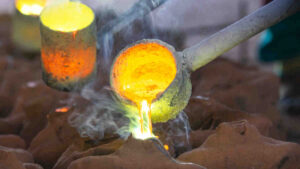MoneyTalks: Is this the best value gold company in Australia right now?

Pic: DKosig / iStock / Getty Images Plus via Getty Images
MoneyTalks is Stockhead’s regular recap of the ASX stocks, sectors and trends that fund managers and analysts are looking at right now and in this edition we’re looking at one expert’s view on best value gold company in Australia.
Today we hear from Simon Catt, a director from Arlington Group Asset Management and an Australian expat who has lived in London for two decades.
“We like to back great companies with great assets and management; take a long-term view,” he said.
“We’ll quite often take a contrary view because we think it is important at what price you buy into the asset or the company and we look globally.”
Wiluna Mining (ASX:WMX)
Catt says this company is the “best value gold company in Australia”.
He has been following the Wiluna gold project for nearly his entire career but wasn’t a big fan of it until a couple of years ago.
“In 2019, we had the right guy come onboard the company at the right gold price,” he said.
“The guy’s name is Milan Jerkovic. He’s the executive chairman, he’s got a really capable Chief Operating Officer – a guy called Neil Meadows – and we always liked the asset, but waited for right guy with the right pla.
“Wiluna’s got a lot of gold, 7 million ounce resource, plus a 600,000 ounces reserve at 4.7 grams [per tonne] and what the current management team, which have been in place for three years, have started to focus on is underground sulphide ounces.
“If you look back at 100 years of Wiluna’s history there has been 4 million ounces mined against the current 7 million ounce resource, 600,000 ounce reserve and the average grade of those historical sulphide ounces mined, which make up 3 of the 4 million historically mined, is 7g/t.”
With the average grade of Australian underground gold mines at 4-5g/t, Catt says Wiluna is in the right ballpark with a 4.7g/t resource currently but thinks the reserve will grow in both size and grade based on average mine grade of 7g/t and as the company uses new exploration techniques and deploys a $30 million annual exploration budget.
“It’s quite a a shallow mine, most of those ounces are 200-300m down to 600m deep whereas the average depths of Australia’s successful large underground gold mines – names like St Barbara’s (ASX:SBM) Gwalia Mine, Northern Star’s (ASX:NST) Jundee Mine, Kirkland Lake (ASX:KLA) Fosterville Mine – these have been going deeper using new exploration techniques,” he said.
“So we think that’s what’ll happen to Wiluna, as they use modern techniques like Hi-Seis using some of the same tools as these mines to look deeper. As the drillbit turns we think they’ll find more and higher grade ounces.
“We invested in [a recent] equity raise, $114m at current prices of $1 per share, plus the company has $54m in debt from a London trading house called Mercuria and is currently producing 50,000 ounces of gold increasing to over 100,000 ounces by this time next year.
“So we think Wiluna is the best value and that’s quite a controversial call considering recent history view of the asset – and that’s the opportunity – we think it’s the best value gold company in Australia.”
Wiluna (ASX:WMX) share price chart
Lefroy Exploration (ASX:LEX)
As if “the best value gold company in Australia” if wasn’t enough, Catt also gave his thoughts on the best exploration idea right now. He thinks it’s Lefroy.
“We think it could be this year’s Chalice (ASX:CHN),” he declared.
Chalice was last year’s resources success story with its nickel-copper-palladium discovery.
But how is this Kalgoorlie gold-copper stock similar to Lefroy? Catt recalls the initial discovery hole for Chalice’s Julimar discovery in March last year as COVID-19 first spread across the globe.
“I looked at it and thought ‘Wow that was a serious drill hole, you’ve got palladium, copper, nickel, only 80km from Perth, great infrastructure’,” he said.
“The stock went up five times in the first 3-4 months after that discovery hole. It was trading at 20 cents and went up to $1-$1.50 so it went up five times, was trading at a market cap of $100-$150 million.
“I thought I missed it and then of course it’s gone up a further eight-plus times, so we think Lefroy is in the same situation today. (Of course it is exploration and depends on what the drillbit comes up with on their burns Project).
“Lefroy made a porphyry discovery at Burns, which is unusual in those Archaean age very old rocks, they drilled 38m at 7.6g/t and 0.6% copper back in February and we’re waiting for those follow-up holes to come,” he said.
“[Lefroy] got a diamond rig, they poked holes in which results in 2-3 weeks from the follow-up assays [are due].
“It has gone up five times from discovery hole, but if they have a porphyry it could be like something Newcrest’s (ASX:NCM) Cadia mine. And it’s next to Kalgoorlie, so a nice easy place to develop and Lefroy has 100% of it.”
Catt also likes that Lefroy’s main shareholder is tier one gold producer Gold Fields (NYSE:GFI) and that Lefroy’s boss Wade Johnson is an expert on this region, in a former life running Newmont’s operations in Australasia.
“There’s lots of copper and gold on surface – lots of smoke- but what Lefroy did differently from previous explorers like WMC and Octagonal Resources was they drilled on other side of an intrusion and they drilled deeper and made that discovery,” he said.
“So what we did, which may seem counter-intuitive, is doubled our bet in Lefroy since discovery – at five times the original entry price and are waiting to see the assays.
“The quality of Lefroy’s management, board and share register suggests the Burns discovery could be the real thing.
“At our DISCOvery webinar [last week], we asked Tim Goyder what should investors back in a junior exploration company, he said a couple of things: ‘You should make sure the board and management own lots of shares, you want them to do lots of drilling, take the projects on. If they miss, move on – you fail fast and keep going, don’t become wedded to any project’.
“‘Junior explorers need to have access to capital, so long term patient shareholders like Gold Fields are important to keep the drill rigs turning.
“And you want to have smart geologists having a red hot go, we believe Wade Johnson CEO at Lefroy has the geological experience, tenacity and backing to make a serious discovery.”
Lefroy Exploration (ASX:LEX) share price chart
Thungela Resources (London:TGA)
Having tipped the best value gold company in Australia and the best exploration idea for 2021, Catt concluded with a London coal pick.
Many coal companies globally are doing well with economies bouncing back from COVID-19, but there’s something that makes this newly listed company stand out.
Namely, it was a spin-off of Anglo-American’s coal assets in South Africa.
“Anglo gave away 28 million tonnes of coal production, it also put US$200 million cash into the company and gave it an off-take [agreement] and minimum price guarantee,” he said.
“You’ve got [a] super strong balance sheet, income protected with a five-year offtake with Anglo, 16 million tonnes of annual production (and 12 million domestic South African sales and valuation today is US$370 million producing 16 million tonnes of coal a year. All-in costs are around US$60 per tonne and revenue line is about $100 per tonne hence the margin is US$40 per tonne on the export coal.
“Let’s compare that to [ASX coal miner] Whitehaven (ASX:WHC). Whitehaven is a beautiful company, it produces about 20 per cent more coal – 20-21 million tonnes of thermal coal versus 16. Costs similar, about US$60 per tonne and Whitehaven receives an additional $20/tonne for its higher grade coal hence a $60 per tonne margin versus Thungela’s $40/t margin.
“So if we look at earnings, Whitehaven should produce about $1-$1.2b of EBITDA – against [a market cap of] $2 billion, add A$800 million ot net debt nearly 3 times EV to EBITDA. These companies are cheap compared to BHP (ASX:BHP). It’s on 16 times versus EBITDA whereas Whitehaven is on about six times EBITDA.”
Catt says Thungela is trading at an even greater discount with a market cap of US$370 million, of which US$200 million is cash, but with US$600 million forecast earnings provided coal prices hold up.
“That tells us Thungela is a triple compared to Whitehaven even with a South African discount and both companies are cheap compared to their mining peers.”
At Stockhead, we tell it like it is. While Wiluna and Lefroy are Stockhead advertisers, they did not sponsor this article.
The views, information, or opinions expressed in the interviews in this article are solely those of the interviewees and do not represent the views of Stockhead.
Stockhead does not provide, endorse or otherwise assume responsibility for any financial product advice contained in this article.
Related Topics

UNLOCK INSIGHTS
Discover the untold stories of emerging ASX stocks.
Daily news and expert analysis, it's free to subscribe.
By proceeding, you confirm you understand that we handle personal information in accordance with our Privacy Policy.








